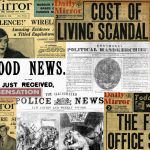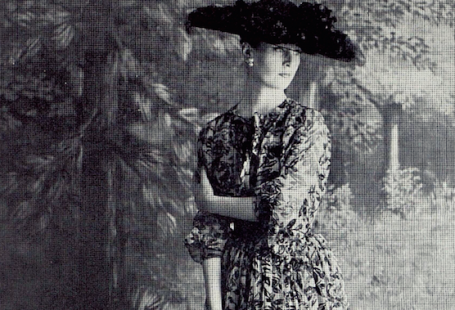This week at The Archive we have reached another fantastic milestone – we now have over 54 million newspaper pages available to search. Meanwhile, we have added 111,378 brand new pages over the past seven days, with the addition of five brand new titles, three of which cover the town of Bromley. Furthermore, we’ve added two more intriguing titles, one of which was tied to the Spiritualist movement in the Victorian era, whilst the other is a wonderfully illustrated title that was founded in the 1890s.
In addition to this, we’ve updated sixteen of our existing titles this week, with significant updates to one of our Caribbean titles, the Barbados Agricultural Reporter. So read on to discover more about all of our new and updated titles of the week, as well as to find out more about famous Victorian medium Florence Cook, who was at the centre of a controversy in the 1870s.
Register now and explore the Archive
The Spiritualism movement has its origins in the state of New York, coming into life in the 1840s. Spiritualism is the belief that spirits of the dead not only exist, but can also communicate with the living, and this idea was thrown onto the international stage when sisters Kate (1837-1892) and Margaretta Fox (1833-1893), of Hydesville, New York, claimed to have communicated with the spirit of a murdered pedlar.
From this point onwards, the Spiritualism movement went global, although in 1888 Margaretta admitted that their communication with the dead was a hoax, but she later recanted this. Meanwhile in 1852 American medium Maria B. Hayden (1826-1883) visited London and conducted séances, attracting people from all social classes. Even Queen Victoria herself was an early proponent of Spiritualism; she attended a séance as early as 1846.
The Spiritualism movement in Britain became very much a type of counter culture, and it especially attracted women. Women were at the heart of the movement; from the Fox sisters to other mediums like Cora L.V. Scott (1840-1923) and Achsa W. Sprague (1827-1862), and it was wildly believed that women made better mediums because they were more emotionally sensitive.

And it was out of this movement that one of our new titles this week, the Spiritualist, was born. A key title of the Spiritualist movement, it was first published on 19 November 1869, dubbing itself as ‘A Record of the Progress of the Science and Ethics of Spiritualism.’ Initially appearing on a fortnightly basis at the cost of three pence, it joined other British Spiritualist titles like The Spiritual Magazine, Human Nature, and Daybreak. But the new publication was not started to ‘compete with these three journals,’ as its debut edition stated:
…it is intended to occupy new ground, and to meet a want as yet unsupplied. At the Gower-street Conferences last winter, several of the speakers mentioned the want of reports and records of public meetings connected with Spiritualism, and one chief object of this new journal is to chronicle the proceedings of such assemblies. Another feature of the Spiritualist will be, its scientific character. A third feature, of considerable value to the subscribers, is seen on pages seven and eight of this number, in the shape of a large quantity of well-authenticated evidence that Spiritualism deserves most serious investigation. This evidence, written for the benefit of all non-Spiritualists, will be republished regularly…

To these ends, the Spiritualist reported on different meetings of Spiritualist groups, whilst also looking at the movement across Britain, for exampling showcasing Spiritualism in East London and Bloomsbury, as well as further afield, reporting on Spiritualism in New Zealand. True to its promise of being of a ‘scientific nature,’ the publication also contained ‘Scientific Investigation of Spiritual Phenomena,’ as well as looking at a variety of ‘Spirit Greetings’ from the likes of Lord Bacon and Emanuel Swedenborg (1688-1772), whose writings heavily influenced the Spiritualism movement.
As well as featuring poetry and ‘General News’ surrounding the movement, the Spiritualist was also positioned towards ‘non-Spiritualists,’ in attempt to try and convince them of the virtues of the movement. The Spiritualist therefore featured a section entitled ‘Facts for Non-Spiritualists’ and another called ‘Testimony of Non-Spiritualists.’

In 1882 the publication changed its name to Psyche, and it was in that year that its publication came to an end. It remains one of the most influential titles associated with British Spiritualism, and is a fascinating record of Victorian Spiritualism in Britain.
Remaining in Victorian Britain now, and we’re delighted to welcome a brand new illustrated title to our site, which is ‘Illustrated Record and Review’ Black & White. Founded in 1891 by writer and journalist Charles Norris Williamson (1859-1920), this illustrated weekly periodical cost six pence and filled 35 pages. A lively reflection of contemporary life, Black & White was famed for publishing fiction by the likes of Henry James, Bram Stoker, H.G. Wells, Jerome K. Jerome, and others.

At the heart of Black & White, however, were the publication’s illustrations, which depicted a range of themes, events and places, and could be purchased separately from the journal upon request. Black & White would feature depictions of sporting events, for example publishing drawings of ‘Steeplechase Incidents,’ as well as containing images of the latest theatrical productions. A mainstay of the publication was a section entitled ‘The Week in Parliament,’ which was unusual for the time as it actually pictured politicians of the day involved in speeches and debates.
Meanwhile, Black & White looked at news from abroad, typically featuring illustrations from far flung places, with a section called ‘Here and There in the Empire.’ The publication also featured music news, the latest from ‘The Art World,’ reviews of books, portraits of contemporary personalities, and ‘original drama’ scripts. Each edition would come with a contents listing that copy’s illustrations.

On 14 October 1899 the publication changed its name to the Black & White Budget, becoming on 30 May 1903 the Black & White Illustrated Budget. In 1912 it was incorporated with fellow illustrated title The Sphere, which you can also view on The Archive.
We move to Bromley now to introduce our trio of titles from that town, which was originally part of Kent and now lies in Greater London. Our first Bromley title this week is the Bromley and West Kent Telegraph, a Liberal title which was established in 1865. Appearing every Saturday, it was initially titled the Bromley Telegraph, St. Mary’s Cray, Sevenoaks and Local Journal, and cost just one pence.

Circulating in ‘Bromley and neighbourhood,’ the Bromley and West Kent Telegraph featured local news from Beckenham, Chevening, Greenwich, Herne Hill, Sevenoaks, Sittingbourne, Maidstone, Mark Cross, Westerham, Widmore, Tonbridge, Tunbridge Wells, as well as reporting on the Croydon Petty Sessions and local railway the London, Brighton, and South Coast Railway. The paper also contained notices of marriages and deaths, whilst also detailing the national news headlines.
Hot on the heels of the Bromley and West Kent Telegraph was the Bromley Journal and West Kent Herald, which was founded four years later and was first published on 21 May 1869. Conservative in its politics to its rival’s Liberalism, it was the sister paper of the historic Maidstone and Kentish Journal, which was established in 1786.
Appearing every Friday, the Bromley Journal was established ‘At the request of a large and influential body of Conservatives in the Western Division of the county,’ as the first edition of the new newspaper declared. The first edition went on to describe how:
The district of which Bromley is the centre contains a very large population, amidst whom the Conservative element is particularly strong, and the promises of support which we have already received leave no doubt as to the success of our undertaking. The object with which we set out is to supply a good readable local newspaper, in which will be found all the news of the district carefully and impartially reported…The Bromley Journal will, in fact, be the local organ of the Conservatives, of whose views it will be the recognised exponent.

Indeed, the venture appeared to be success, with the Bromley Journal in the 1880s having ‘a very large circulation in Bromley, Bickley, Beckenham, Chislehurst, the Crays, and throughout West Kent.’ It was furthermore reported how it:
Is unanimously taken and read by, and has the loyal support of, the Conservatives throughout the whole division of Kent, and is by far the best newspaper, and most influential medium for advertisements in the district
So what could you find within this newspaper’s pages? Well, there was ‘Local Intelligence’ from the likes of Blackheath, Woolwich, Beckenham, Eltham, Horton Kirby, Dartford, and Gravesend, with a look at the Locksbottom Petty Sessions, the Plumstead Election of Vestrymen, the Bromley Church Lectures, the Bromley Local Board and the Bromley Bicycle Club. Indeed, the Bromley Journal had a particular focus on sport, with an especial emphasis on cricket and the progress of the local area’s teams. Meanwhile, the newspaper looked beyond Bromley to detail ‘Court and Fashion’ news, the latest from the worlds of ‘Literature, Science and Art,’ and news from parliament.
Our final new title of the week is the Bromley Chronicle, which was founded in 1891 and appeared every Thursday. Costing just one halfpenny, it was first published on 10 September 1891, filling four pages at a ‘convenient size.’ This Liberal title promised to uphold the news from the local area first and foremost, its first edition stating how:
…our chief aims will be to make it a ‘news’ paper in fact as well as in name, and to the effect that the news of our town shall be that pre-eminently recorded in it…In local matters we shall take an independent course, being in no way committed either to approve or to oppose the policy of the existing local powers that be, or of their critics.

The Bromley Chronicle was truly a local paper, therefore, featuring the latest from the Bromley School Board, the Bromley Petty Sessions and the Bromley Rural Sanitary Authority. It also looked at sport, with reports on cricket and lawn tennis, with an overview of the week’s news sitting alongside ‘Natural History Notes’ and serialised fiction.
That’s it from our five new titles of the week, but do remember we have updated sixteen of our existing titles this week. We’ve added nearly 20,000 pages to the Barbados Agricultural Reporter, whilst we’ve added new pages to one of our Welsh titles, the Pontypridd Observer, whilst new pages have joined Scottish title the Airdrie & Coatbridge Observer. Meanwhile, we’ve made a range of additions to our English regional titles, from the Aldershot News to the Salford Advertiser.
‘Spirit Forms’ – Florence Cook and Katie King
In the early 1870s British medium Florence Cook (1856-1904) took the Spiritualist world by storm, as she performed séances and appeared to materialise a spirit named Katie King. Whether or not Florence was a fraud became a controversy that dominated the mid-1870s, and our new title the Spiritualist provides a wonderful insight into Florence and the impact she had upon the Spiritualist movement.

The Spiritualist was home to a lively correspondence section, and in February 1873 Amelia Corner, from Hackney, took it upon herself to write to the publication and describe the abilities of Florence Cook:
Allow me a little space to record an interesting séance at my own house, through the mediumship of Miss Cook, showing that Miss Cook’s mediumship is not confined to the manifestation of spirit faces, however excellent they may be, as all unprejudiced persons who have had the good fortune to witness them must acknowledge.
The séance began with Florence Cook writing something down, Amelia Corner going on to relate how:
We were able to read the message by holding it before a toy mirror one of my children happened to have by. ‘All sit; I will give you tilts and raps – Katie.’ The tilts commenced immediately, and were soon succeeded by raps, low at the commencement, but gradually increasing in sound, and answering all questions put by us in an intelligent manner.

After that, the spirit of Katie ‘trotted’ the table where the séance was being conducted to a different part of the room, whereupon she ‘entranced’ her medium Florence, chatting to the group ‘in a most social manner.’ Then Katie said:
‘I will make my medium as tall as Carrie,’ and while she was still sitting, she rose apparently from a little below the waist, like the drawing out of a telescope, and was suddenly shot down to her normal size. This was repeated three or four times. She then said, ‘My medium shall walk as tall as Carrie,’ and she rose from her chair and was again elongated; she walked about half-a-dozen steps and back to her chair again, after which she was restored to her normal state, without any appearance of exhaustion.
Further testimony of Florence Cook’s remarkable abilities were to be found in the pages of the Spiritualist. The publication on 1 November 1873, under the heading ‘Spirit Forms,’ described several séances conducted by the medium, all of them having been ‘good ones.’ One such was attended by a Mr. C. Blackburn and Miss Blackburn of Manchester, who searched Florence Cook before the séance began, to protect against any accusations of fraud.

Florence’s ‘hands were then secured with tape,’ whilst she was also ‘fastened to the floor in the cabinet,’ from where she would be conducting the séance. With these measures in place, the spirit of Katie appeared to manifest, with the Spiritualist relating how:
The spirit came out of the cabinet with bare feet, robed from head to foot in white, as usual, in a good light. She talked for about an hour as usual, entering and leaving the cabinet occasionally; once she walked about a yard from the cabinet, towards the centre of the room.
There were some who believed that the spirit of Katie King was Florence herself, or indeed an accomplice. But there were others who firmly believed in Florence and in Katie, like S.C. Hall, who wrote to the Spiritualist in June 1874 in support of the medium and her abilities.

Despite having been ‘present only once when the ‘materialised spirit’ known as ‘Katie’ appeared,’ Hall wrote:
I state that I did distinctly see the form said to be a ‘materialised spirit’ and the form of Florence Cook at the same time. The ‘spirit’ was standing in the door-way, and Florence Cook was on the ground at a distance of about four feet from the ‘spirit.’ I passed into the room and raised Florence Cook from the ground, and ascertained that the form I had seen on the ground was Florence Cook.
He did admit that if the appearance of Katie was ‘a most infamous and blasphemous fraud,’ Florence Cook was not to blame, as it would be ‘some other person’ who was impersonating the spirit. Hall goes on to state his case, describing the differences in appearance between Florence and Katie:
Florence Cook is short, the ‘spirit’ is tall – the one two, or perhaps three inches taller than the other. The hair of Florence is dark; that of the ‘spirit’ light. Florence Cook has ears pierced, and wears ear-rings; the ears of the ‘spirit’ has no marks of ear-piercing. The foot of the ‘spirit’ is rather large; that of Miss Cook is small. The faces of the two were, to my mind, very dissimilar: that of Miss Cook is small and round; that of the ‘spirit’ long and solemn.

Whilst historians have posited that Katie was indeed Florence, and at other times an accomplice, we will never know for sure whether or not Florence Cook was a fraud, and the Spiritualist provides a fascinating record of her mediumship.
New Titles
Title |
Years Added |
| Black & White | 1891-1899, 1902, 1905 |
| Bromley and West Kent Telegraph | 1868-1872, 1886-1896, 1898-1913 |
| Bromley Chronicle | 1891-1892, 1894-1896, 1898-1921 |
| Bromley Journal and West Kent Herald | 1869-1885, 1887-1902, 1905-1912 |
| Spiritualist | 1869-1882 |
Updated Titles
This week we have updated sixteen of our existing titles.
You can learn more about each of the titles we add to every week by clicking on their names. On each paper’s title page, you can read a FREE sample issue, learn more about our current holdings, and our plans for digitisation.
Title |
Years Added |
| Airdrie & Coatbridge Advertiser | 1976 |
| Aldershot News | 1981 |
| Barbados Agricultural Reporter | 1887-1888, 1895-1910 |
| Cheshunt and Waltham Mercury | 1996 |
| Derbyshire Times | 1921 |
| Faversham Times and Mercury and North-East Kent Journal | 1989 |
| Harrow Observer | 1996 |
| Hounslow & Chiswick Informer | 1988 |
| Kensington News and West London Times | 1936 |
| Nantwich Chronicle | 1977 |
| Newcastle Daily Chronicle | 1928 |
| North Star (Darlington) | 1920 |
| Nottingham Recorder | 1989 |
| Oldham Advertiser | 1989 |
| Pontypridd Observer | 1989 |
| Salford Advertiser | 1992 |
You can keep up to date with all the latest additions by visiting the recently added page. You can even look ahead to see what we’re going to add tomorrow.






